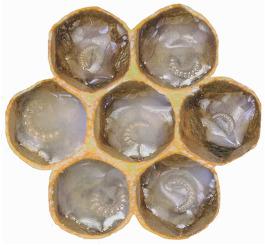Chemosphere ( IF 8.1 ) Pub Date : 2021-09-08 , DOI: 10.1016/j.chemosphere.2021.132214 Christina Kast 1 , Verena Kilchenmann 1

|
While many studies have examined residue levels in beeswax, little is known about the levels that pose a risk for honey bee development. In an in vitro study, we aimed to assess the toxicity of pesticides in wax for worker larvae using coumaphos as a model substance. First, we reared larvae in beeswax with the aim to correlate the larval toxicity to the corresponding levels of coumaphos in beeswax. In a second step, we tested to which extent coumaphos migrates from the beeswax into the larval diet and if such dietary levels are toxic to larvae.
We observed dose-related toxicity when larvae were exposed to coumaphos concentrations in beeswax from 30 to 100 mg/kg. The lethal concentration in 50% of the individuals (LC50) was calculated to be 55.9 mg/kg, while the no observed effect concentration (NOEC) for exposure of larvae to coumaphos in wax was 20 mg/kg. Additional test series without larvae allowed to assess the migration of coumaphos from the beeswax into the diet. The resulting dietary coumaphos concentrations were four to five times lower than the initial concentrations in wax. In accordance, the LC50 for chronic exposure of larvae to coumaphos in the diet was 12.5 mg/kg, which was 4.5 times lower than the LC50 obtained for wax exposure. Finally, a coumaphos level of 20 mg/kg in wax led to a dietary concentration of 3.9 mg/kg that was close to the NOEC of 3 mg/kg obtained in the diet.
In conclusion, both experimental approaches suggest that coumaphos concentrations of up to 20 mg/kg in wax are non-lethal.
中文翻译:

一种评估蜂蜡中农药对蜜蜂幼虫毒性的体外模型
虽然许多研究已经检查了蜂蜡中的残留水平,但对蜜蜂发育构成风险的水平知之甚少。在一项体外研究中,我们旨在使用香豆磷作为模型物质评估蜡中农药对工蚁幼虫的毒性。首先,我们在蜂蜡中饲养幼虫,目的是将幼虫毒性与蜂蜡中相应水平的香豆磷相关联。在第二步中,我们测试了香豆磷从蜂蜡迁移到幼虫饮食中的程度,以及这种饮食水平是否对幼虫有毒。
当幼虫暴露于蜂蜡中浓度为 30 至 100 mg/kg 的香豆磷时,我们观察到了剂量相关的毒性。50% 的个体 (LC 50 )的致死浓度计算为 55.9 mg/kg,而幼虫暴露于蜡中香豆磷的未观察到影响浓度 (NOEC) 为 20 mg/kg。没有幼虫的附加测试系列允许评估香豆磷从蜂蜡到饮食中的迁移。由此产生的膳食香豆磷浓度比蜡中的初始浓度低四到五倍。据此,幼虫长期暴露于日粮中香豆磷的 LC 50为 12.5 mg/kg,比 LC 50低 4.5 倍获得蜡曝光。最后,蜡中 20 mg/kg 的香豆磷水平导致日粮浓度为 3.9 mg/kg,接近日粮中 3 mg/kg 的 NOEC。
总之,两种实验方法都表明,蜡中浓度高达 20 mg/kg 的香豆磷是非致命的。











































 京公网安备 11010802027423号
京公网安备 11010802027423号